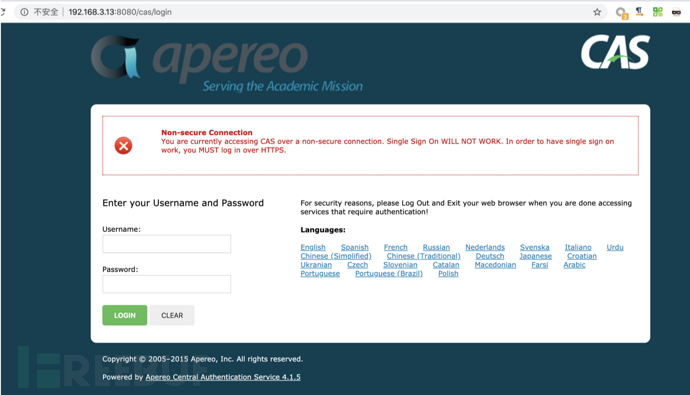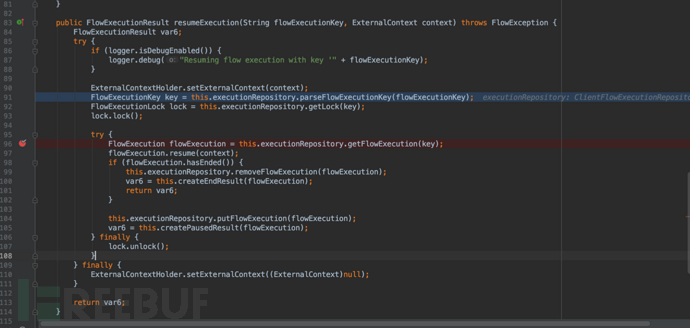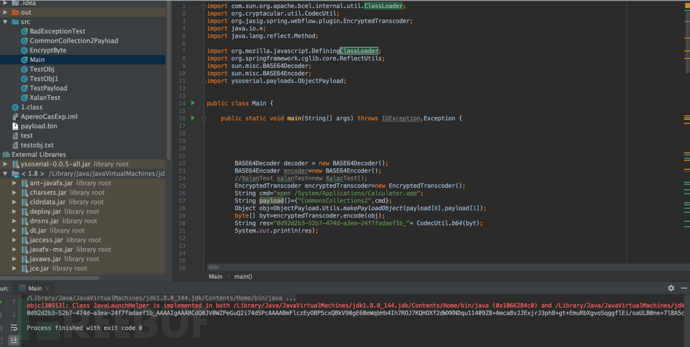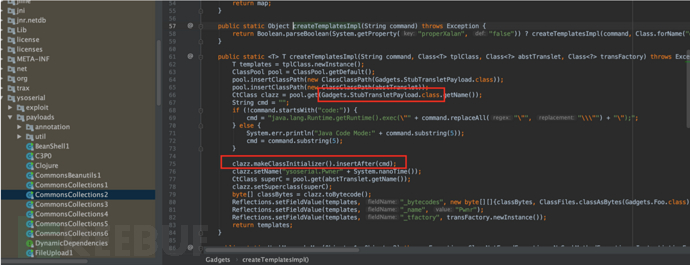
0×01 前言
放假前看到很多文章对这个漏洞进行分析复现,又因为过年期间的特殊情况,实在是无聊至极,所以自己也来学习一下,顺便恶补一下反序列化漏洞的知识。这篇文章记录了自己的一些想法以及相关的知识点,方便自己日后忘记可以重新拾起。第一次写文章有不好的,希望大家见谅。
0×02 环境搭建
由于部分cas版本的加密函数不同有相应的变化,因此想要按照此文章来复现漏洞的话还是选择和我一样的版本。
jdk8u144(不一定完全一样)
ApereoCas-4.1.5
下载CAS-Overlay-Template
github链接:https://github.com/apereo/cas-overlay-template/tree/4.1
github上有详细的部署操作,这里要注意要修改pom.xml文件cas的版本:
<cas.version>4.1.5</cas.version>
编译完后,会在target目录生成一个cas.war的war包,将该war包放在tomcat的web目录上,启动tomcat即可通过http://localhost/cas访问example。
成功部署后:

0×03 漏洞分析
该漏洞存在于登录的execution参数,抓包发现该参数值应该是加密过的,故要知道对应的加密方法以及处理过程才行。

web.xml
查看登录url对应的servlet可知道交给了Spring的DispatcherServlet处理了,配置文件为/WEB-INF/cas-servlet.xml

从springmvc的执行流程图(网上找的)可以知道只要找到对应的处理器适配器,就能找到对应的处理器。

cas-servlet.xml
全局搜索login字眼,看到loginHandlerAdapter适配器,处理器的类名为org.jasig.cas.web.flow.SelectiveFlowHandlerAdapter

org.jasig.cas.web.flow.SelectiveFlowHandlerAdapter该类继承FlowHandlerAdapter类,登录时调用继承类的handler方法:
//org.springframework.webflow.mvc.servlet.FlowHandlerAdapter#handle
public ModelAndView handle(HttpServletRequest request, HttpServletResponse response, Object handler) throws Exception {
FlowHandler flowHandler = (FlowHandler)handler;
this.checkAndPrepare(request, response, false);
String flowExecutionKey = this.flowUrlHandler.getFlowExecutionKey(request);
if (flowExecutionKey != null) {
try {
ServletExternalContext context = this.createServletExternalContext(request, response);
FlowExecutionResult result = this.flowExecutor.resumeExecution(flowExecutionKey, context);
this.handleFlowExecutionResult(result, context, request, response, flowHandler);
} catch (FlowException var11) {
this.handleFlowException(var11, request, response, flowHandler);
}
} else {
try {
String flowId = this.getFlowId(flowHandler, request);
MutableAttributeMap<Object> input = this.getInputMap(flowHandler, request);
ServletExternalContext context = this.createServletExternalContext(request, response);
FlowExecutionResult result = this.flowExecutor.launchExecution(flowId, input, context);
this.handleFlowExecutionResult(result, context, request, response, flowHandler);
} catch (FlowException var10) {
this.handleFlowException(var10, request, response, flowHandler);
}
}
return null;
}
其中flowExecutionKey通过getFlowExecutionKey方法获取参数execution的值
String flowExecutionKey = this.flowUrlHandler.getFlowExecutionKey(request);
flowExecutionKey作为参数传入resumeExecution方法,跟进函数。在第91行对flowExecutionKey值的格式进行判断,通过”-”分割字符串为两部分uuid以及base64编码flowstate,因此格式不满足的话是无法继续走下去的。


跟进第96行getFlowExecution。
public FlowExecution getFlowExecution(FlowExecutionKey key) throws FlowExecutionRepositoryException {
if (!(key instanceof ClientFlowExecutionKey)) {
throw new IllegalArgumentException("Expected instance of ClientFlowExecutionKey but got " + key.getClass().getName());
} else {
byte[] encoded = ((ClientFlowExecutionKey)key).getData();
try {
ClientFlowExecutionRepository.SerializedFlowExecutionState state = (ClientFlowExecutionRepository.SerializedFlowExecutionState)this.transcoder.decode(encoded);
FlowDefinition flow = this.flowDefinitionLocator.getFlowDefinition(state.getFlowId());
return this.flowExecutionFactory.restoreFlowExecution(state.getExecution(), flow, key, state.getConversationScope(), this.flowDefinitionLocator);
} catch (IOException var5) {
throw new ClientFlowExecutionRepositoryException("Error decoding flow execution", var5);
}
}
}
在第105行对之前base64解码后的encoded进行解密,跟进解密函数this.transcoder.decode(encoded)


可以看出在第83行对密文进行解密,经过一系列的操作后在99行进行反序列化,触发漏洞。可以看出调用的decode方法属于EncryptedTranscoder类,该类还定义的加密方法encode,这里可以直接生成恶意对象,直接调用org.jasig.spring.webflow.plugin.EncryptedTranscoder#encode生成加密字节数组后base64,加上”uuid-”构成execution的值。
整个调用栈

0×03 构造payload
默认环境的jar包中有commons-collections4-4.0.jar,直接使用ysoserial生成payload,这里记得要将payload的特殊符号进行url编码。


演示结果
成功执行系统命令

0×04 构造回显payload
看了大佬的分析,知道可以回显,文章提及到org.springframework.webflow.context.ExternalContextHolder.getExternalContext()方法可以获取到上下文关联信息,然后通过getNativeRequest()方法获取request对象通过getNativeResponse()方法获取response对象。同时提及到org.springframework.cglib.core.ReflectUtils.defineClass().newInstance();加载payload。我的猜测大佬的想法是通过defineClass从byte[]还原出一个Class对象,该恶意对象主要是执行命令,获取response对象,将执行命令后的结果通过response对象的输出流输出。在利用commons-collections1是发现ReflectUtils利用不了,因为构造方法为private,要设置setAccessible为true。因此使用commons-collections2的话,实际就不需要这么麻烦用defineClass来加载payload了,直接在利用类里面写就好了。
//org.springframework.cglib.core.ReflectUtils
private ReflectUtils() {
}
//org.springframework.cglib.core.ReflectUtils#defineClass
public static Class defineClass(String className, byte[] b, ClassLoader loader) throws Exception {
Object[] args = new Object[]{className, b, new Integer(0), new Integer(b.length), PROTECTION_DOMAIN};
Class c = (Class)DEFINE_CLASS.invoke(loader, args);
Class.forName(className, true, loader);
return c;
}
这里看看ysoserial的commons-collections2的构造恶意对象的主要方法。这里使用javassist,第66行获取要操作的类,第75行在该类的构造方法中插入代码,因此这里只要修改该类ysoserial.payloads.util.Gadgets.StubTransletPayload的构造方法为执行系统命令,并修改response的输出流。大家可以直接修改ysoserial的源码并重新编译,我这里为了方便直接用了网上的payload改了一下。


演示结果

0×04 最后
文章中存在错误的地方希望大佬们斧正,多多指点。通过这次的分析,其实学到很多东西的,包括commons-collections利用链、ysoserial源码分析。最后,在新的一年里希望大家身体健康,万事如意。
https://www.00theway.org/2020/01/04/apereo-cas-rce/
https://www.freebuf.com/vuls/170344.html
*本文作者:DreamXu,转载请注明来自FreeBuf.COM
如有侵权请联系:admin#unsafe.sh